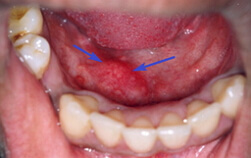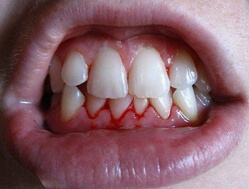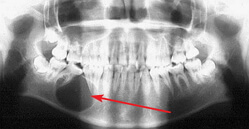Enamel hypoplasia
 Enamel hypoplasia is a defect in the development of tooth tissues, which manifests itself in a violation of the mineralization and structure of the tooth tissues during their formation. In most cases, there is a violation of the formation of only enamel, but in some particularly severe cases, dentin. The extremely pronounced form of this disease is aplasia of the enamel, which is manifested by the absolute absence of enamel coating. Hypoplasia in some - anywhere reveal almost 50% of children of primary school and pre-school age, and in most cases it is systemic in nature and is expressed in the lesions of several teeth
Enamel hypoplasia is a defect in the development of tooth tissues, which manifests itself in a violation of the mineralization and structure of the tooth tissues during their formation. In most cases, there is a violation of the formation of only enamel, but in some particularly severe cases, dentin. The extremely pronounced form of this disease is aplasia of the enamel, which is manifested by the absolute absence of enamel coating. Hypoplasia in some - anywhere reveal almost 50% of children of primary school and pre-school age, and in most cases it is systemic in nature and is expressed in the lesions of several teeth
Causes
The main reasons for the development of enamel hypoplasia include metabolic disorders( especially mineral metabolism) In the fetus during the period of tooth formation. In addition, in recent years, based on numerous observations and studies, it was found that infectious diseases( toxoplasmosis, rubella, SARS, etc.) And toxicosis in pregnant women also lead to the development of the disease. Underdevelopment of enamel is observed in children who received birth trauma, as well as in premature infants. Predisposing factors for enamel hypoplasia are rickets,
atopic dermatitis , encephalopathy and other metabolic disorders calciumManifestations enamel hypoplasia
The disease diagnosed as temporary and permanent teeth and appears different in magnitude depigmentation or whitish spots with a shiny smooth surface. Such spots can be combined with cup-like or dotted grooves, depressions, peri-enamel crowns of teeth. Enamel in these foci loses its inherent color, but retains its density. In some cases, there may be a complete absence of enamel coating in the form of a cup-shaped depression in a limited area of the tooth. Very rarely the enamel is absent practically on the entire surface of the tooth, as a result of which the tooth acquires an ugly, bizarre shape. Most often, enamel hypoplasia is observed in the region of the cutting edge of canines, incisors and knolls of the first molars.
Clinically, enamel hypoplasia is distinguished into the following forms:
- Spotted form of hypoplasia( 46.8% of patients).On the surface of the enamel there are spots of white color, with a shiny smooth surface and clear boundaries, which are located on the same level of symmetrically arranged crowns of teeth. Symmetry is characteristic not only for the location of the spots themselves, but also for their sizes and shapes.
- Borozdchataya form of hypoplasia( 5.2% of patients).Furrowed enamel grooves are observed, different in depth and width, located parallel to the cutting edge;wherein the bottom of these grooves enamel layer significantly thinned, and in some cases completely absent
- Erosive form hypoplastic( 27.3% of patients).It is expressed by the thinness of the enamel layer in a limited area in various places of the tooth crown. In most cases, defects have a rounded shape and are arranged symmetrically on the same teeth, while having the same size
- Mixed form hypoplastic( 20.7% of patients).It expressed alternating erosion and white spots on the teeth, or a combination of erosion, stains and grooves
Treatment hypoplasia enamel
The treatment of the disease depends on the degree and form hypoplastic. In the presence of single spots and superficial lesions of the enamel coating, etiotropic treatment is not performed. In the presence of spotted hypoplasia, the affected areas are ground or bleached with medicinal agents. In the event that changes in the enamel are expressed in the interceptions and pinholes, they are filled with composite materials. If the defects of the enamel and dentin are pronounced, a complex treatment with the subsequent installation of metal-ceramic crowns is prescribed. In order to prevent the development of caries, remineralizing therapy is carried out.



